Blood gushed from his mouth
2020.06.17 18:39 Hideaki Kimura
10 min read
Philippine-grown bananas — the proud centerpiece of every supermarket fruit section (*1). But unknown to shoppers, beatings, harassment, arson, and gun violence hound those who produce and pack these bananas for Japan. In October 2018, a man was even murdered.
Eighty-six percent of bananas sold in Japan come from the Philippines. One distributor is Sumifru Japan, whose local arm Sumifru Philippines oversees bananas produced and packed on Mindanao Island (*2). Formerly known as Sumitomo Corporation’s 100% subsidiary Sumisho Fruits, Sumifru Japan is currently a subsidiary of Sumifru Singapore. In June 2019, Sumitomo Corporation announced it would sell its 49 percent stake in the latter.
At the company’s packing plants, workers and their families have faced continuous harassment and violence, which escalated in response to a workers’ strike that began on Oct. 1, 2018.
Workers at eight packing plants formed a joint labor union called “Nagkahiusang Mamumuo sa Suyapa Farm” (Namasufa). Out of the eight plants, workers from seven went on strike to demand regular employment and collective bargaining rights from Sumifru (*3). The strike has continued for over 300 days. Sumifru fired all 749 workers taking part (*4).
The strike was prompted by workers’ low pay and long hours (*5). Despite being always on their feet and shifts running late into the night, workers still cannot support their families with their meager wages.
The bananas we buy in Japan are so cheap thanks to these low wages and long hours.
I visited Mindanao Island, which was under martial law from 2017 to the end of 2019, to learn the story behind the bananas sent to Japan.
“The cops are here. I’m scared”
My flight landed in Davao, Mindanao Island’s biggest city and the third most populous in the Philippines, on the night of Aug. 5, 2019. I then headed northeast by car for about two hours until I reached the site of the banana packing plants — the town of Compostela, population 87,000 (*6).
A family of Namasufa members put me up for the night. All around us was the Sumifru banana plantation. Male union members kept watch over the house, to make sure the military or police did us no harm.
A little after 6 a.m. the next morning, Aug. 6, I drove to the Sumifru management office with Namasufa Secretary Melodina Gumanoy (43).
After driving through the banana plantation for about 15 minutes, we reached the office, located in Compostela’s San Jose barangay (*7). A crowd of about 40 workers, fired by Sumifru, had already gathered in front of its gate.
The Philippines’ Department of Labor and Employment’s National Labor Relations Commission had ordered Sumifru to reinstate its fired workers. The crowd had gathered to see whether they could return to work.
A guard holding a gun stood just inside the Sumifru plant’s iron gate. Two officers from the National Labor Relations Commission stood facing him. But the guard only repeated that management would not be in until 8 a.m. As we watched, the guard closed and locked the gate.
One of the commission officers, Dexter Burlaza (41), told us, “We’ll check the other packing plants next. We’ll give them until noon. If Sumifru doesn’t agree to reinstate the workers, we’ll say as much in our report.”
We followed the commission officers’ car. As we drove, Gumanoy received a text from a union member who had been waiting in front of the packing plant: “The cops are here. We’re scared.”
“Don’t worry. Stay calm,” Gumanoy replied.
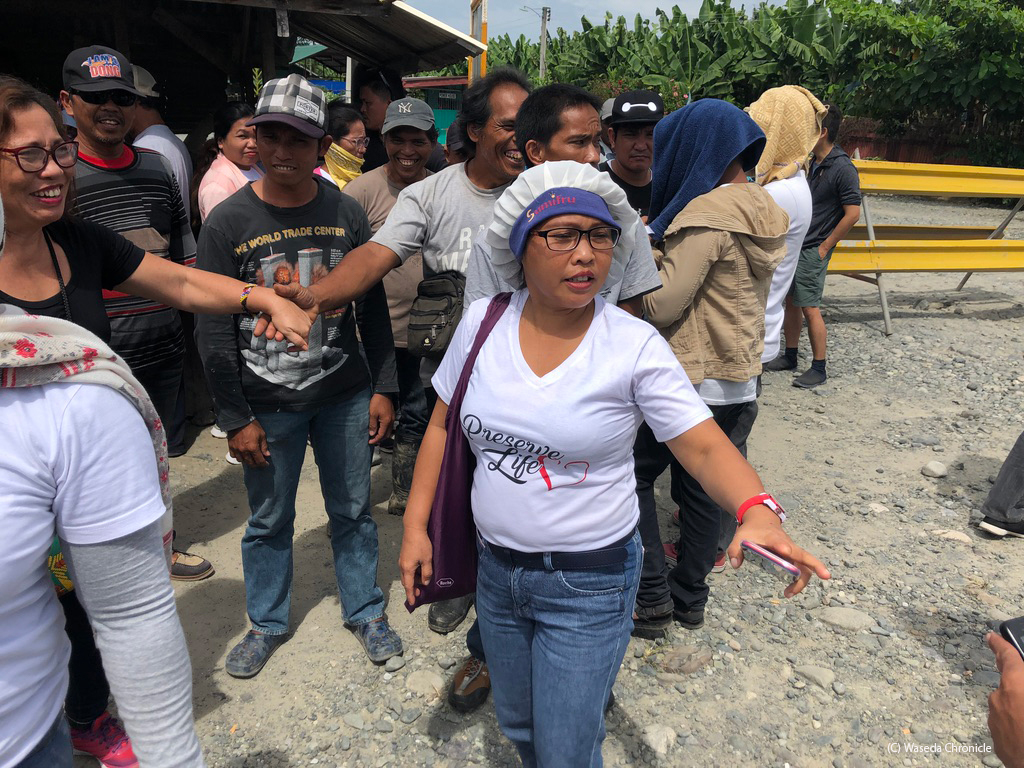
Melodina Gumanoy gives instructions to union members in front of a Sumifru packing plant. She is wearing the Sumifru work hat she used at the plant. Photo taken on Aug. 6, 2019 in Compostela, Compostela Valley (now Davao de Oro) Province, Philippines. (C)Tansa
A little after 8 a.m., a car that had been following ours stopped at one of the packing plants, and two men got out. They were from Sumifru. “Management will meet with you now, so please return to the office,” they told the commission officers. This was the first time in the 300 days since the strike began that Sumifru had agreed to direct talks. The commission officers replied that they would return once they had seen all the packing plants. The men from Sumifru followed us in their car, taking photos of us with their smartphones. A police car followed as well, its officers holding rifles against their chests.
Two union leaders entered the Sumifru office together with the commission officers around 10:45 a.m. Gumanoy waited outside the gate to hear the conclusion of their talk, which continued for over an hour and a half. By this time, well over 200 union members thronged in front of the gate.
At last, the union leaders emerged after finishing their discussion. They shared its results via megaphone with the crowd at a nearby basketball court. Sumifru was refusing to hire back its workers despite the labor department’s order. However, if union members agreed to once again be hired through dispatch agencies, rather than regular employment, the company said they could return to work.
Gumanoy was glad for this small concession. “Returning to work means we’re back at the starting line. It’s a step forward,” she said.
But the situation hadn’t changed.
“Wages are still low, so it will be hard to get by even if we can go back to work. I don’t know how long we can support ourselves like this. And I’m sure the harassment and threats to union members will continue,” Gumanoy said.
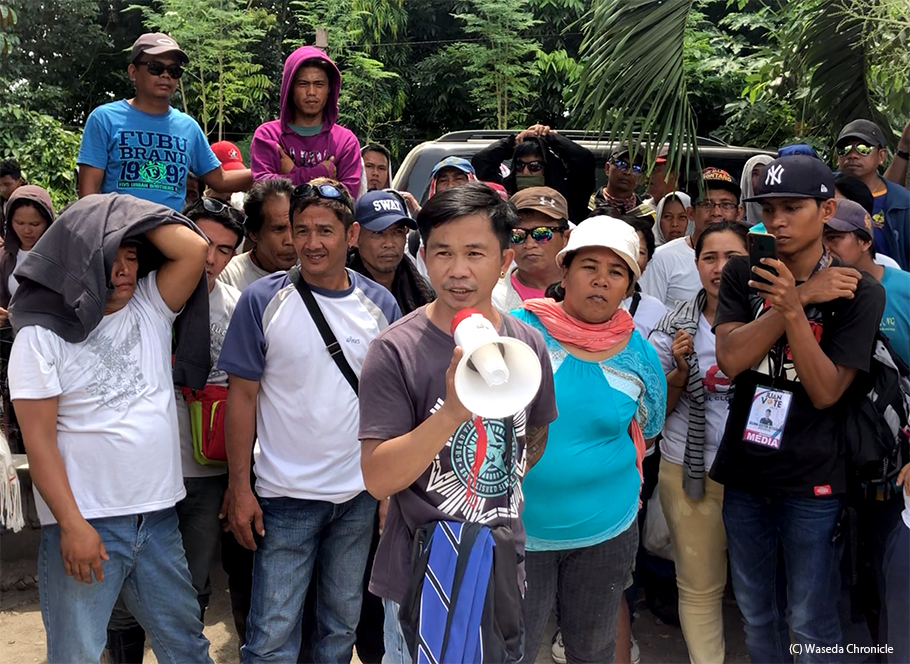
Joint labor union Namasufa Vice-President Elizar Diayon (center) explains the outcome of negotiations with Sumifru to union members. Photo taken on Aug. 6, 2019 in Compostela, Compostela Valley (now Davao de Oro) Province, Philippines. (C)Tansa
Fired upon in front of her home
Gumanoy has worked at banana packing plants since she was 20. She had to drop out of high school in her second year when her father became ill.
She has experienced increasing harassment since becoming Namasufa’s secretary.
Gumanoy started receiving texts telling her to quit the union. Strange men came to her neighborhood, asking which house was hers. Her neighbors always answered that they didn’t know. Around 11 p.m. on April 20, 2019, 10 men riding two to a motorcycle showed up near her house. Gumanoy stayed hidden but heard them fire five shots. On Aug. 20, 2018, she was shadowed by men on motorcycles as she made her way to work at the factory. That time, Gumanoy escaped danger by hiding in a house.
“People worry about me and say I should quit the union. But I tell them that what we’re doing is for the next generation too. We aren’t doing anything wrong. We’re prepared to deal with harassment,” she said.
Although she was away from Compostela at the time, lobbying for the union in Davao, Gumanoy can’t forget what happened on Oct. 11, 2018.
It began around 3 p.m.
“Leave him alone!”
They were 10 days into the strike.
About 60 union members were demonstrating outside the gate of the Sumifru packing plant where Gumanoy worked. They were preventing trucks loaded with bananas from leaving the plant. Since morning, workers protesting at the other packing plants had been attacked one after another.
Suddenly, soldiers and police appeared beside the striking workers. Men dressed in plain clothes were among them. According to a witness, it was a group of about 150 people.
The men in plain clothes held guns. Everyone believes they were Sumifru’s hired goons.
Suddenly, the men charged.
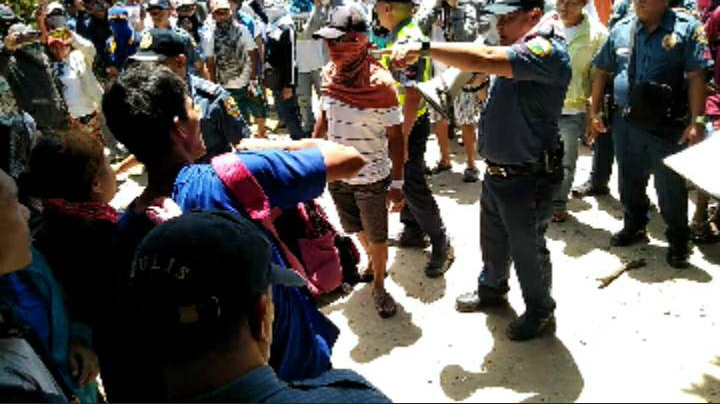
The Oct. 11 attack. The assault was carried out by men wearing hats to hide their faces. A police officer points to the union members, and it is thought he is identifying who the men should attack. That day, similar assaults began in the morning and occurred one after another at seven packing plants. Photo taken on Oct. 11, 2018 in Compostela, Compostela Valley (now Davao de Oro) Province, Philippines. (C)KMU-SMR
They attacked the Namasufa members and seized the banner they were holding. Wilson B. Baticula (60), who was leading the protest, told everyone to run. But a woman had fallen. She couldn’t get away. The men grabbed her, beat her. The sight stopped Baticula in his tracks.
Three men rushed him. They seized Baticula and wrapped cords they were holding around his neck. When Baticula tried to grasp the cords and run, one of the men struck him on the left side of his jaw.
Blood gushed from his mouth.
It streamed onto his purple t-shirt. Baticula fell backward, but the men kept punching and kicking him. His wife, Jenefer (48), and sister were nearby. They tried to stop the beating.
“Leave him alone!”
Jenefer’s shout only made her the men’s next target.
Chaos reigned.
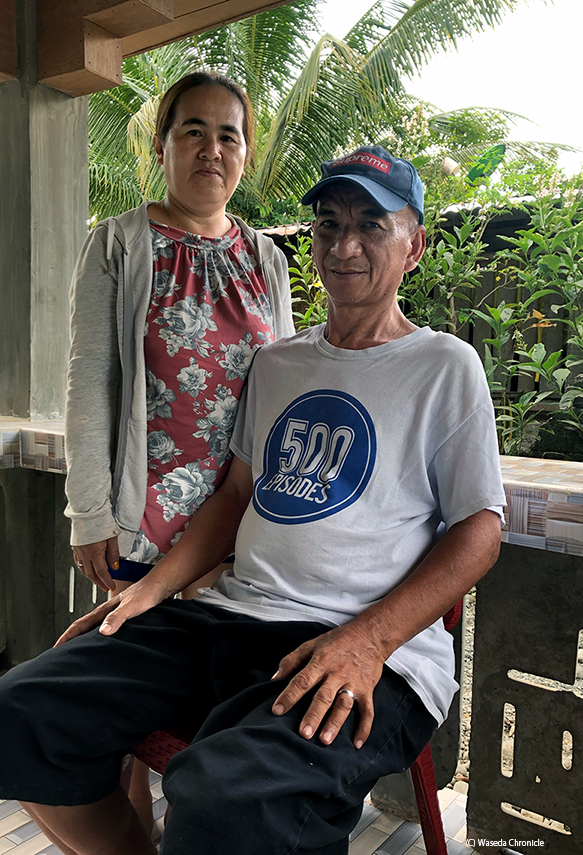
Wilson Baticula cried as he recounted the attack. His wife, Jenefer, is on the left. Photo taken on Aug. 8, 2019; Compostela, Compostela Valley (now Davao de Oro) Province, Philippines. (C)Tansa
“You’re killing him!”
Angelite Jaca (50), who was also nearby, saw Baticula spitting blood.
“That’s enough! You’re killing him!” he yelled.
This time, the three men who had beaten Baticula turned on Jaca. One yelled, “So you’re a red too!” The union was “red tagged,” labeled as communist. Two other men joined the fray and grabbed Jaca’s arms. The first three went behind him, striking and kicking his back. Jaca collapsed, but the assault continued.
The union members scattered. Marilyn Beringuel (51) hid in a toilet behind a sari-sari store near her house. She was pursued all the way there, but her neighbors claimed not to be union members. The men left.
The soldiers and police had merely watched.
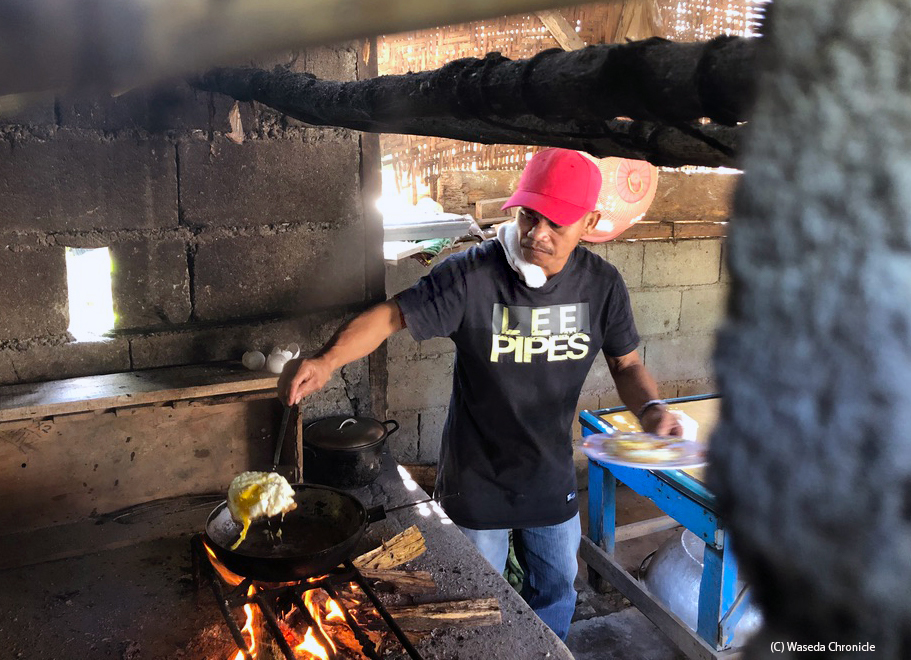
Angelite Jaca cooks breakfast. He is in charge of food for union meetings. Photo taken on Aug. 10, 2019 in Compostela, Compostela Valley (now Davao de Oro) Province, Philippines. (C)Tansa
The assault on Baticula had gone on for over three minutes. His wife and others first carried him home, then to a church, which the union used as a makeshift shelter and hospital. Baticula received medical care and spent the night there. Even after returning home, he had trouble sleeping, wondering when the next attack would come. Jaca too was carried home and treated at the same church as Baticula. His injuries continue to pain him, and he goes to a hospital for regular treatment (*8).
Many other union members were injured in the attack too (*9).
In Davao, Gumanoy heard what happened over the phone. Her colleagues and friends had been beaten bloody. She rushed to the labor department’s Davao office.
“Please, help us!”
But the labor department staff only replied, “There’s nothing we can do. We’re under martial law. The military is in charge here.”
“We will die if you don’t stop them,” she said, angry. “We’re obeying the law. Why won’t you help us?”
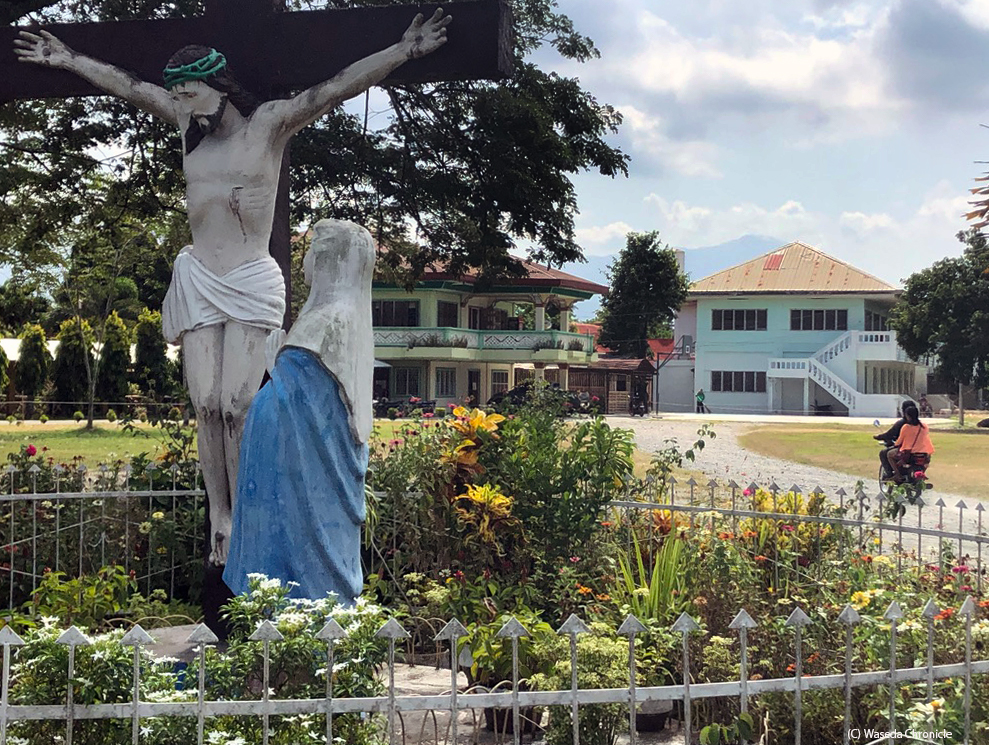
The church that was used to treat the wounded. Photo taken on Aug. 15, 2019 in Compostela, Compostela Valley (now Davao de Oro) Province, Philippines. (C)Tansa
“Danny Boy Bautista has been killed”
Gumanoy’s words came to pass 20 days later, on Oct. 31.
She was at the union office that day, along with many of the strikers. In the evening, a union member returned from the market.
“Danny Boy Bautista has been killed,” she told them.
“Are you sure?”
“But, he’s one of us!”
Danny Boy was a young Namasufa member who helped with security. He worked hard for the union even after finishing his shifts at the banana plantation.
Gumanoy immediately suspected that this was the work of Sumifru goons. About two months earlier, on Sept. 4, one of the union leaders had been fired upon, but all six shots missed. The incident had taken place around 6 a.m., as he made his way to work.
But it had only been a matter of time before someone was killed over the bananas bound for Japan.
At their office, 15 union members bundled themselves into a van and headed for the scene of the crime.
… To be continued.
Ages are given as of the time of interview. Investigative partners: Alternative People’s Linkage in Asia, Friends of the Earth Japan, Pacific Asia Resource Center (PARC)
(Originally published in Japanese on Aug. 19, 2019)
Footnotes
*1: Bananas were first commercially imported to Japan in 1903 from Taiwan; at the time, Taiwan-grown bananas dominated the Japanese market. In 1958, the Philippines began to study banana cultivation in response to Japan’s import liberalization. Japan liberalized banana imports in 1963; in 1973, the Philippines became the number one exporter of bananas to Japan. Since then, Philippine-grown bananas have comprised the greatest share of the Japanese market. Sources: Yoshiyuki Tsurumi’s Banana to nihonjin — Philippine noen to shokutaku no aida (Iwanami Shoten, Publishers; 1982); Sumifru Japan, Banana Daigaku, etc.
*2: Sumisho Fruits was established in 1970 as a 100% subsidiary of Sumitomo Corporation. In 2011, the company name changed from Sumisho Fruits to Sumifru. In 2016, Sumifru’s business was completely handed over to Sumifru Japan. Sumifru Japan’s bananas account for 27.9% of the Japanese market (as of 2016). Sumifru Japan is a subsidiary of Sumifru Singapore; Sumitomo Corporation held 49% of Sumifru Singapore’s shares. In June 2019, Sumitomo Corporation announced that it was selling all of its Sumifru Singapore shares, stating that it was “leaving the Philippine banana business.” Sources: Sumifru Japan corporate register and website; Japan Fresh Products Import-Export and Safety Association’s “2016 Banana Imports by Associations Members (importers and producers separate),” etc.
*3: The joint labor union Nagkahiusang Mamumuo Sa Suyapa Farm (NAMASUFA-NAFLU-KMU, written in this series as Namasufa) was formed on 9 August 2018 between the labor unions at eight Sumifru packing plants. The joint union had 931 members when it was established. It has a board of directors made up of three leaders from each plant’s union, as well as a five-member Executive Committee (ExCom) comprised of a president, vice-president, secretary, treasurer, and auditor. Seven of the eight plant unions participated in the strike (749 workers). Namasufa is part of the Philippines’ National Federation of Labor Unions (NAFLU), and it is affiliated with the leftist Kilusang Mayo Uno (KMU, “May First Movement”). Sumifru claims that it is illegal for plants to form a joint labor union.
*4: On Jan. 30, 2019, the Philippines’ National Labor Relations Commission ordered Sumifru to rescind its dismissal of union members, as there was insufficient evidence to support the reason given for their dismissal. In addition, the Supreme Court of the Philippines ruled on June 7, 2018 that workers at one of the Sumifru packing plants must be recognized as direct employees.
*5: The joint labor union Namasufa identified the following problems with their working conditions: no employment contracts; no paid leave for maternity or emergencies; four hours of compulsory overtime work at packing plants; no retirement pay; workers are obligated to stand for long periods of time; insufficient measures regarding exposure to chemicals; harassment of union members; etc. According to Melodina Gumanoy, break times are from 11 a.m. to noon, 3 to 3:15 p.m., and 7 to 7:30 p.m. Break times can differ by plant and duties; for Jocelyn Lagroma, who works at a different plant, break times are from 10:30 to 11:30 a.m., 3:30 to 4 p.m., and 6:30 to 7 p.m.
*6: Total population by province, city, municipality, and barangay as of August 1, 2015
*7: The San Jose barangay has a population of 4,457. Compostela is comprised of 16 barangay, which vary in population between 972 and 8,348. San Jose is a mid-sized barangay in Compostela. Source: Total population by province, city, municipality, and barangay as of Aug. 1, 2015
*8: Angelite Jaca receives regular treatment at the public hospital Southern Philippines Medical Center in Davao. He receives free treatment under Davao’s “Lingap para sa Mahirap” program to assist the poor. From April 7 to May 9, 2019, he stayed at the KMU office while going to the hospital for treatment. The program can only accommodate 100 people per day, so Jaca queued at the hospital from 4 a.m. to receive a numbered ticket guaranteeing his spot.
*9: Namasufa submitted a letter to the secretary of the Department of Labor and Employment on Dec. 27, 2018. According to the letter, a minimum of 27 people sustained serious injuries from the attacks at the seven packing plants. The total number of injured exceeds 200.
Sweet Bananas, Bitter Work: All articles
 Newsletter signup
Newsletter signup